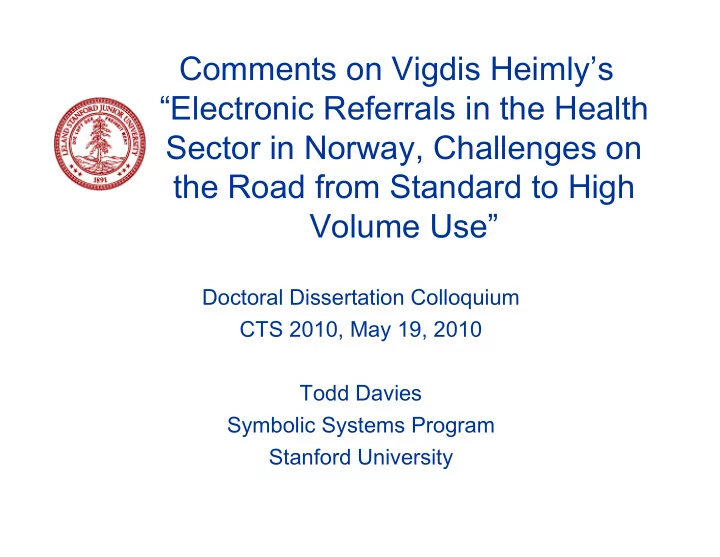

Comments on Vigdis Heimly’s “Electronic Referrals in the Health Sector in Norway, Challenges on the Road from Standard to High Volume Use” Doctoral Dissertation Colloquium CTS 2010, May 19, 2010 Todd Davies Symbolic Systems Program Stanford University
Reactions to ERSes generally Electronic referral systems (ERS) are an excellent example of Lessig’s phrase “Code is law.” ERSes appear to have high potential to benefit patients, doctors, and society, but there are tradeoffs to consider Some possible effects: • Speed and efficiency of communication • Shift from point-to-point message to a durable record visible by all stakeholders, including multiple providers • Ability to connect referral directly to patient records, giving specialist more info • Gain in ability to triage, with greater transparency • Gain in ability of GP to monitor and follow-up with patient and specialist
Reactions to ERSes generally (continued) Some tradeoffs: • Patient freedom to select provider versus provider triage • Visibility to stakeholders versus patient privacy • Patients who want to choose provider versus those who want GP to choose (from Heimly 2009 article in Medical Informatics ) • GP time spent helping patient choose versus time spent with other patients (social welfare) or doing more lucrative services (in fee for service environments)
Reactions to Heimly’s findings so far Clearly a need for systematic cross-country comparison along dimensions of difference - what ERS works under a given type of health care regime Some dimensions: • Portable versus directed referrals • Rich info versus all-or-nothing referrals • Function of ERSes under fee-for-service versus fixed- salary care centers • Function of ERSes under nationalized versus private medical insurance systems
Reactions to Heimly’s findings so far (continued) Possible approach: meta-analysis of existing literature (extending 2009 Medical Informatics article) as a component of analysis directed at Norway’s system Domain is also excellent candidate for participatory design involving patients, doctors, and technologists
Reactions to Heimly’s research plan Work plan does not indicate intention to interview patients, as opposed to care providers - Is this correct? How much is the focus on Norway as opposed to cross-country analysis? Possible hybrid: use cross-country analysis as a basis for evaluating Norway’s roll-out
Recommend
More recommend